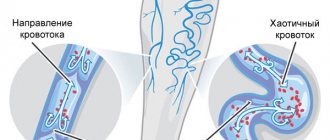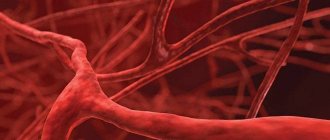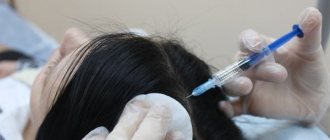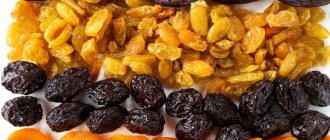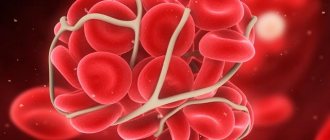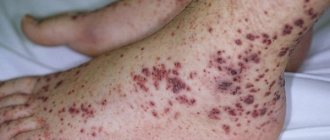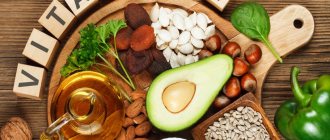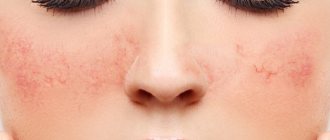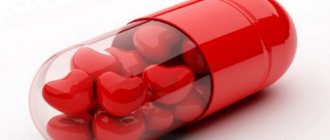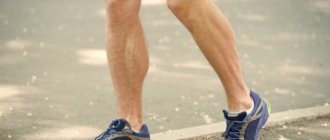07.09.2017
For any disease, the doctor can prescribe vitamins as maintenance therapy; in each case, the selection of vitamins differs depending on the needs of the body. To treat varicose veins, vitamins are prescribed to strengthen the walls of blood vessels, increase their tone, normalize metabolism and improve the functioning of the immune system.
Some of the beneficial substances are produced by the body, others are not, then you need to replenish their amount with the help of food or medications. Vitamins D, A, C, P, E, B, K have the greatest impact on the health of the veins. Listed below are the drugs prescribed by the doctor and their effect on the body.
Vitamins P and C (rutin and ascorbic acid)
Rutin is a bioflavonoid that can reduce capillary fragility and the permeability of blood vessel walls. This is an excellent venotonic that can increase the elasticity of blood vessels. This vitamin is found in the white part of the peel of citrus fruits. To get the maximum effect from rutin for varicose veins of the legs, it is prescribed in tandem with vitamin C. Together they work well together, increasing each other’s effectiveness. Ascorbic acid is useful for various diseases, it:
- makes the walls of blood vessels stronger;
- reduces the harmful effects of free radicals on cells;
- increases the body's defenses;
- stimulates hematopoiesis.
It is not difficult to get vitamin C from foods - it is found in leafy vegetables, orange and yellow vegetables and fruits, green onions, lemon and kiwi. When exposed to high temperatures, vitamin C is destroyed, so to get it from vegetables and fruits you need to eat them raw.
Contraindications to the use of leeches
So, do such contraindications exist? Of course. This is a decrease in blood clotting, increased bleeding, including gums, anemia, pregnancy, very thinness and accelerated metabolism, individual intolerance to leeches, as well as pregnancy. You should also not administer leeches to children and very elderly people, especially those with weakened bodies.
Leeches should not be placed in places where the skin is too thin - this harms the skin and blood vessels underneath it. Therefore, you should not place a leech directly over a vessel, especially if it is a vessel with damaged walls.
Tocopherol is the main natural antioxidant. It protects our cells from the harmful effects of free radicals, prevents premature aging, and participates in the synthesis of collagen and elastane. As soon as they don’t call it for this: the vitamin of youth and beauty, a protector against cancer, a guardian of motherhood.
Strengthening cell membranes is precisely the function of tocopherol that interests us today. Without a sufficient amount of vitamin E in the body, the skin and muscles become flabby, the walls of blood vessels and capillaries also weaken, and as a result, you get all the sad prerequisites for the development of varicose veins.
Vitamin E is a fat-soluble substance and is found mainly in vegetable oils.
- Oil from sprouted wheat grains – 300 mg/100 g;
- Soybean oil – 170 mg/100 g;
- Cottonseed oil – 100 mg/100 g;
- Sunflower oil – 75 mg/100 g;
- Almonds – 27 mg/100 g;
- Hazelnuts (hazelnuts) – 25.5 mg/100 g;
- Confectionery margarine – 25 mg/100 g;
- Corn and flaxseed oil, walnuts – 23 mg/100 g;
- Soybeans – 17.3 mg/100 g;
- Peanut oil – 14 mg/100 g;
- Corn and peanuts – 10 mg/100 g;
- Coconut oil – 8 mg/100 g;
- Olive oil – 7 mg/100 g;
- Buckwheat kernel – 6.65 mg/100 g;
- Wheat cereal – 6.5 mg/100 g;
- Cashew nuts – 5.7 mg/100 g;
- Dried apricots (dried apricots) – 5.5 mg/100 g;
- Rye – 5.3 mg/100 g;
- Fresh sea buckthorn – 5 mg/100 g;
- Whole grain bread – 3.8 mg/100 g.
Vitamins E and A (tocopherol and retinol)
Vitamin E is involved in blood microcirculation, reduces tissue swelling, and has an anticonvulsant effect. Tocopherol is found in vegetable oil (olive sunflower, sesame and corn), legumes (lentils, soybeans, beans and peas), as well as leafy vegetables, cabbage, liver and egg yolks, seeds and nuts.
Retinol promotes tissue regeneration and cell restoration, thanks to which wounds heal faster, including trophic ulcers after varicose veins. Vitamin A is found in liver, fatty meats, milk and animal products. You can also eat carrots, apricots and cabbage; they contain carotene, a precursor to retinol.
Traditional recipes for varicose veins
Dr. Walker is an American nutritionist who has created an entire system for combating leg diseases, in particular varicose veins. He suggested using juices for treatment, but not store-bought ones, but natural, freshly squeezed ones.
Juices have a huge advantage over foods: they are absorbed immediately after drinking them and have the most positive effect on all systems of the body. Especially on hematopoiesis and blood flow.
What juices are best to make to treat varicose veins?
Vitamins K and D
Vitamin K affects blood clotting and is involved in thrombus formation. This vitamin is responsible for fibrin threads, which are considered the basis of a blood clot. If there is not enough substance in the body, the blood does not clot well, which leads to bleeding. The danger threatens people whose varicose veins have weakened the walls of the blood vessels and at any moment they can rupture, which will lead to severe bleeding. You can get vitamin K from cucumbers, cabbage, tomatoes, carrots, potatoes, pumpkin, berries, bananas, kiwi and vegetable oils.
Calciferol or vitamin D refers to those vitamins that are produced in the body. Production requires sunlight, so doctors recommend walking. Vitamin deficiency can also be replenished by eating certain foods. Vitamin D promotes tissue regeneration, normalizes metabolism, and increases the amount of calcium in bone tissue. Calciferol is found in meat, fish, eggs, dairy products and offal.
Vitamin C strengthens blood vessels
Varicose veins do not require adherence to a strict diet, but there are foods that, by consuming, can help your vessels remain healthy, clean and elastic for as long as possible. Just include these foods in your diet and they will help you get rid of excess cholesterol, capillary fragility and high blood pressure problems naturally. Everything in our body is interconnected - there will be no reasons, and there will be no unpleasant consequences.
Chilli
Recently, a group of scientists from Hong Kong took a keen interest in the properties of capsaicinoids. These are alkaloids found in some plants and give them a pungent taste and spicy aroma. One of these plants is the well-known chili pepper, which is very popular in Chinese cuisine. It turned out that red pepper not only gives dishes a piquant taste, but also has a beneficial effect on the entire cardiovascular system. How does he do this?
Studies on hamsters have shown that capsaicin works effectively in two ways:
- Reduces the level of “bad cholesterol”, but does not affect the level of “good” in any way. Fights cholesterol plaques: prevents the clogging of blood vessels with fat and breaks down already formed clots so that blood can circulate freely;
- Inhibits the activity of the gene responsible for the production of a substance called cyclooxygenase-2. Every person normally has this substance, but heart patients and hypertensive patients have more of it than they need. The danger is that cyclooxygenase-2 causes small muscles located around blood vessels to contract. And this interferes with normal blood supply and provokes surges in blood pressure.
Thus, regular consumption of hot chili peppers will allow you not only to improve your appetite, speed up the production of gastric juice and facilitate digestion, but also keep your blood vessels in good shape. For varicose veins, it is recommended to eat food seasoned with red hot pepper at least once a day, of course, if you have no contraindications to this from the gastrointestinal tract.
Ginger
Another aromatic spice that can help patients with varicose veins is ginger root. A lot has been said about the fact that this unique plant helps lose weight, strengthens the immune system, treats colds and increases libido. But today we are interested in exactly how ginger affects blood vessels.
What does this mean in practice? Ginger helps you lose weight because high oxygen levels are needed to burn fat during exercise. But the vessels also contain fat, dangerous fat at that, and gingerol allows you to get rid of it. This means that ginger can definitely be recommended for people suffering from varicose veins. You can purchase this root and brew delicious, aromatic tea at home.
Ginger tea to strengthen blood vessels:
- Fresh grated ginger - 4 tablespoons;
- Zest of one lemon;
- Honey to taste.
Place the ginger and zest in a glass or porcelain teapot with a capacity of at least one liter, pour boiling water over the ingredients and leave for half an hour. Then pour the tea into a mug, wait until it cools to a temperature of 50-60 °C, and add honey. This tea not only perfectly cleanses blood vessels with varicose veins, but also saves from seasonal colds, migraines and menstrual pain.
We are used to thinking that vitamin C is some kind of energy drink that helps us quickly cope with seasonal colds.
But the functions of ascorbic acid in the human body are much broader and more significant:
- Vitamin C is involved in the synthesis of the hormone adrenaline, which means it directly affects our resistance to stress;
- The same vitamin is necessary for sufficient absorption of iron and the production of red blood cells - erythrocytes, which is why a deficiency of ascorbic acid leads to a deterioration in blood quality;
- Finally, the main thing is that vitamin C is needed for normal venous blood flow, thorough removal from the blood of harmful impurities, breakdown products and low-density lipoproteins, the same “bad” cholesterol that clogs our blood vessels.
People suffering from varicose veins, or having a predisposition to this disease, should absolutely not be allowed to have a vitamin C deficiency in their body.
How do you know if you are lacking ascorbic acid? Here are some signs:
- Frequent and prolonged colds;
- Depression or apathy;
- Poorly healing abrasions, bruises and cuts.
For varicose veins and thrombophlebitis, Ascorutin is prescribed, a drug based on vitamin C and vitamin P (rutin). This tandem allows you to simultaneously improve and cleanse the blood, as well as strengthen the walls of blood vessels and capillaries. But the dosage adopted in our country does not provide a pronounced therapeutic effect.
- Dried rosehip – 1200 mg/100 g;
- Fresh rosehip – 470 mg/100 g;
- Sweet red paprika – 250 mg/100 g;
- Black currant and fresh sea buckthorn – 200 mg/100 g;
- Fresh parsley and sweet green paprika – 150 mg/100 g;
- Brussels sprouts – 120 mg/100 g;
- Fresh wild garlic and dill – 100 mg/100 g;
- Kiwi – 71-92 mg/100 g;
- Cauliflower and red rowan – 70 mg/100 g;
- Oranges, papaya, strawberries, wild strawberries and red cabbage – 60 mg/100 g;
- Fresh spinach and grated horseradish – 55 mg/100 g;
- Kohlrabi cabbage – 50 mg/100 g;
- Grapefruits and white cabbage – 45 mg/100 g;
- Fresh sorrel – 43 mg/100 g;
- Lemons – 40 mg/100 g;
- Tangerines – 38 mg/100 g;
- Beef liver – 35 mg/100 g;
- Gooseberries and rutabaga – 30 mg/100 g;
- Bitter radish – 29 mg/100 g;
- Fresh green peas and radishes – 25 mg/100 g
The world learned about the extraordinary properties of the ginkgo tree from Chinese medicine. These 30-40 meter giants grow throughout almost the entire territory of Southeast Asia and are considered one of the oldest plants on the planet. Suffice it to say that ginkgo comes from prehistoric ferns, and is not at all a coniferous tree, as previously thought.
Ginkgo biloba leaves contain a whole range of unique substances:
- Ginkgolides and bilobalides, named after the plant itself;
- Flavone glycosides;
- Potassium, calcium and phosphorus;
- Thymine, phytosterol, margenine and asparaine.
Ginkgolides and bilobalides make the walls of blood vessels more elastic and also dilate them, which helps lower blood pressure. Glycosides neutralize free radicals and strengthen phospholipid cell membranes, which is very important for brain and cardiovascular health.
The medicinal plant gotu kola also came to Europe from Asia. It grows in India, the Philippines and Sri Lanka and is mentioned in the medical treatises of Ayurveda. It is believed that the ancient Hindus became interested in the longevity of elephants, and suggested that the juicy leaves of gotu kola, a favorite delicacy of heavyweights, had something to do with this phenomenon.
For varicose veins, as well as for the prevention of this disease, vitamins A, B, C, D, E, K and P are useful. Below we will dwell on each type of these elements.
Vitamin A
Retinoids have a serious effect on many functions of the human body, including immunity, reproduction, embryo development, and bone metabolism. However, with varicose veins, the main role of retinoids is in their ability to act as an antioxidant. Retinoids affect the rate of wound healing and also ensure the safety of the epithelium on the walls of the veins.
Retinoids are most abundant in orange and dark green vegetables (spinach, zucchini, pumpkin, carrots) and fruits (citrus fruits, apricots). However, from the point of view of absorption, it is better to give preference to vitamins from animal products (veal or beef, chicken liver, fish, animal oil). There are many retinoids in dairy products (cottage cheese, yogurt, etc.), as well as in eggs.
B vitamins
For the health of blood vessels, 3 vitamins from this group are important - B1, B9 and B12, another name: thiamine, folic acid and cyanocobalamin. The body needs all these vitamins for varicose veins:
- Thiamine is involved in the nervous regulation of blood vessel tone, as well as in the transmission of nerve impulses and regulation of metabolism. If there is not enough of it in the body, this can lead to swelling of the lower extremities, numbness and fatigue of the legs. You can get thiamine from nuts, meat, offal and grains (wheat, rice) and legumes (soybeans);
- B9 and B12 are involved in the regeneration of blood vessel wall cells, stimulate the process of hematopoiesis, and enhance each other’s effect. Folic acid can be obtained from grains and legumes, from vegetables (cabbage, tomatoes, carrots, onions). B12 is found in offal (kidneys, liver and heart) and seafood, seaweed and legumes.
Preventive measures
Varicose veins of the lower extremities are not just a cosmetic problem, the prevalence of which among the population is 30%. If you leave it to chance, there is a chance to get serious complications, such as a trophic ulcer, thrombophlebitis.
Although many people are prone to this disease due to heredity, if you follow the preventive measures listed below, you can prevent the development of the disease.
- Physical exercise. Regular muscle contractions help blood move from the lower to the upper sections and prevent stagnation. Therefore, regular exercise is a guarantee that our veins will be in a healthy state for a long time. Brisk walking, cycling or swimming can all help improve blood circulation in your legs.
- Lifting. Positioning your legs above the level of your heart improves blood flow. A simple way to achieve this goal is to lie down and place them on a stack of pillows. Performing this procedure daily for 10 minutes will prevent the development of varicose veins, and will also prevent it from progressing further if it already exists.
- Control your weight. Extra pounds put extra pressure on your legs, making it difficult for blood to move to your heart.
- Breaths. Deep and frequent breathing helps to quickly saturate the blood with oxygen, which in turn improves blood circulation.
- Wearing loose clothing. Pressure in the calf or groin area prevents the normal flow of blood back to the heart.
- High heels. Many women are too fond of them, which worsens blood circulation in the lower extremities. Low-heeled shoes allow you to “connect the calf muscles to the work of pumping blood.”
- Hot baths. Heat dilates the veins, which slows down blood circulation in the legs. Prolonged sunbathing and frequent visits to the sauna can also contribute to the appearance of this problem.
- Cold shower. A sharp change in temperature helps to “exercise” the veins and stimulate their contraction.
- Crossed legs. This situation impairs blood circulation, making it difficult for it to return back to the heart. When standing for a long time, it is necessary to change the point of main support as often as possible, moving from one leg to the other, and it is also useful to periodically move your fingers.
- Prevention of constipation. A sufficient amount of fiber, fruits and vegetables in the diet will allow the “intestines to work like clockwork.”
Before taking vitamins for the blood vessels of the legs, you should definitely consult your doctor. This is due to the fact that independent initiation of treatment without proper assessment of the severity of the disease usually leads to a delay in the provision of qualified medical care, and this, in turn, can have serious consequences.
We recommend reading the article about sclerosis of blood vessels in the legs.
From it you will learn about the procedure and its effectiveness, possible negative consequences and direct contraindications, and the average cost of sclerotherapy. The use of vitamins for varicose veins, if necessary, should be combined with the use of medications. You should also not forget that lifestyle changes and diet are important components of prevention and treatment, which, along with vitamins, help fight this disease.
The drug Lactomarin
You need to adjust your diet to get the maximum vitamins from food. The rest can be supplemented with pharmaceutical drugs. To get all the necessary vitamins for varicose veins, you can take complex medications. One of the popular ones is Lactomarin. It contains more than 40 useful micro- and macroelements, including phosphorus, chromium, zinc, iron, magnesium, manganese, potassium, vitamins B, E, K, C, alginates, polysaccharides, dietary fiber.
It is important that vitamins are correctly combined with microelements for better absorption. Important for blood vessels: zinc, iron, iodine and copper. They are responsible for the supply of oxygen to the blood, metabolism, and the condition of blood vessels. Lactomarin helps cleanse the body of radionuclides and toxins, improves immunity, and reduces the risk of cancer. There are no preservatives in the vitamin complex; you need to take 150 mg before meals. The course lasts 1-2 months, as the doctor says. Upon completion, you need to take a break for 1 month and then repeat the treatment.
How to replenish the body with vitamins?
There are two ways to make up for the deficiency of nutrients in the body - take pharmaceutical complexes or lean on foods rich in them. It is optimal to combine both options by choosing the right drugs. As for the diet, it should be complete and varied so that foods include a greater variety of minerals and vitamins, especially those needed for healthy veins.
The following products will help people with varicose veins:
- meat and eggs;
- dairy products;
- seafood;
- berries, vegetables and fruits;
- cereals;
- vegetable oils;
- seeds and nuts.
To get the amount of vitamins that the body needs daily, you would have to eat portions of the listed foods. Therefore, some vitamins should be obtained from pharmaceutical preparations. On the pharmaceutical market they are presented in an abundance of drugs for every taste and budget. The cost of the complex depends on the composition, dosage, reputation of the pharmaceutical company, and the balance of the components. The most popular vitamin and mineral complexes that are useful for varicose veins:
- Vitrum;
- Decamevit;
- Biovital;
- Pregnavite;
- Duovit;
- Multi-Tabs;
- Supradin;
- Centrum;
- Undevit.
The attending physician will not only suggest the best option from those listed, but will also give recommendations on the dosage and time of administration, and the duration of the course. When choosing a specific drug, the doctor takes into account the location of varicose veins, the stage of the disease, the age and gender of the patient, and the presence of pathologies. You should not take vitamins at night. Optimally - in the morning, so that the body absorbs all the components. First, it won’t hurt to read the instructions, with the points about adverse reactions and contraindications.
Vitamins alone are not enough to treat varicose veins, but therapeutic nutrition and taking vitamin-mineral complexes play a role in the recovery process. The complex of treatment measures is determined by the doctor.
Vitamin complexes
To prevent venous insufficiency, reduce the risk of thrombosis and improve the rheological parameters of the blood, it is important for every person (regardless of age) to drink vitamin complexes for blood vessels twice a year. This recommendation is especially relevant for people leading a sedentary lifestyle: office workers, hairdressers, surgeons.
The best vitamins for veins and blood vessels:
- "Doppelhertz VIP Cardio System-3" (Queisser Pharma, Germany). It is a rich vitamin and mineral complex, the action of which is aimed at improving lipid metabolism, strengthening the venous wall, normalizing the tone of the vascular bed, and enhancing the nutrition of the heart muscle.
The daily portion of the supplement is divided into 3 multi-colored capsules: orange (“Morning”), yellow (“Day”), brown (“Evening”). The first contains 8 vitamins (, , PP, H, B5, , B9, B12), 2 phospholipids (inositol and choline), 1 macroelement (magnesium). The second consists of vitamin E and omega-3 polyunsaturated fats. The third capsule (“Evening”) contains trace elements (zinc, iodine, chromium, selenium), antioxidant vitamins (C, E, A), lecithin, isoflavones.
The drug is taken three times a day, 1 capsule of the appropriate color. The course of therapy is 2 months.
- “Sophora and vitamins for blood vessels” (Soik LLC, Russia). A therapeutic and prophylactic composition for improving cerebral and peripheral blood circulation, reducing capillary permeability, increasing the elasticity of veins, preventing strokes and heart attacks. The drug includes 7 vitamins (B2, PP, B6, B9, B12, E, C), 6 minerals (magnesium, zinc, chromium, manganese, copper, selenium), 3 plant extracts (Japanese Sophora, garlic, ginkgo biloba ).
The supplement is taken twice a day, 1 capsule with meals.
- “Healthy Heart” (Natural Care, USA). A powerful phytoformula for the prevention and treatment of vascular atherosclerosis, oxygen starvation of tissues, heart failure, venous congestion in the lower extremities. The complex includes plant extracts (hawthorn grass and flowers, turmeric root), vitamins (A, C, E, B12, B9, B6, PP, B2, B1), amino acids (taurine, betaine, L-carnitine), minerals ( selenium, zinc, magnesium, chromium), flavonoids (coenzyme Q10).
To maintain a healthy cardiovascular system, take 2 capsules of the drug per day (after breakfast).
- “Venatol” (Art-life, Russia). Effective “vitamins” for the blood vessels of the legs, with anti-inflammatory, venotonic, neuroprotective and antithrombotic effects. The dietary supplement includes vitamins (P, C, E), plant extracts (horse chestnut, ginkgo biloba, willow), bioflavonoids (rutin, quercetin, hesperidin), minerals (zinc, silicon), amino acid (L-glutathione), enzyme ( bromelain).
Take 3 times a day, 2 tablets with meals.
- Long Life (Vitaline, USA). An antioxidant composition aimed at neutralizing oxidative stress in the vascular wall, increasing the elasticity of arteries and veins, improving blood parameters, and preventing complications of atherosclerosis (strokes, heart attacks, obliterating endarteritis). Active components – bioflavonoids (quercetin, hesperidin), vitamins (E, A, C), herbal extracts (green tea, milk thistle, turmeric, blueberry, bioperine), trace elements (zinc, selenium), aminosaccharide (glucosamine).
"Long Life" is taken 1 - 2 times a day, 1 capsule.
Remember, in addition to taking nutritional supplements to improve vascular tone, it is important to drink at least 2.5 liters of fluid per day (in addition to coffee, tea and first courses).
Useful tips for varicose veins
Above is a list of products that contain those beneficial substances that are needed to improve the condition of blood vessels. To increase the effect of the foods you consume, the healthiest ones can be taken together. For example, to replenish ascorbic acid, you can mix half a cup of cranberries and strawberries, add a cup of raspberries and 100 ml of fresh orange juice. All ingredients are placed in a blender and ground until smooth. This will be a concentrated product containing maximum vitamin C.
People suffering from varicose veins have high levels of fibrin in their blood, a substance that increases blood clotting. The rate can be reduced by substances that make the blood less thick and help strengthen the walls of blood vessels. Every day you need to add garlic and onions to your dishes, drink tea with ginger, if there are no contraindications.
Fiber is useful for both healthy people and patients with varicose veins. Fibrous tissue cleanses blood vessels, rids the body of harmful cholesterol, which is useful for varicose veins caused by atherosclerosis. There is a lot of fiber in plant foods - raspberries, tomatoes, broccoli, melon, white cabbage.
For varicose veins, treatment should be comprehensive, where great importance is given to medications, nutrition, and surgical intervention. If a person does not adjust his diet and balance the amount of vitamins in the body, the disease may return. You can learn more about treatment and prevention measures for varicose veins at your next appointment with a therapist or phlebologist.
Folk remedies in the fight against varicose veins
According to statistics, the leading positions among vascular diseases are occupied by pathologies associated with impaired blood microcirculation in the extremities (varicose veins, thrombosis, phlebitis). These ailments are characterized, among other things, by excessive expansion of surface capillaries (due to loss of elasticity of the venous walls and valves). The first sign of varicose veins is swelling of the legs after exercise or walking. At the same time, spider veins, blue-burgundy spots and painful lumps may appear on the skin of the thighs, legs and feet. In some cases, spasms occur in the calf muscles (especially at night). In the absence of qualified treatment, varicose veins transform into a severe pathology: thrombophlebitis, thrombosis, varicose eczema, trophic ulcer.
To increase the elasticity of the veins and activate blood flow in the extremities (at the initial stage of varicose veins), along with vitamins, folk remedies are used.
Recipes for “homemade” remedies for the blood vessels of the legs:
- Tincture for strengthening veins. Ingredients: cranberries (1 kilogram), black radish (0.5 kilograms), red beets (0.5 kilograms). The specified ingredients are crushed (in a meat grinder, grater or blender) and mixed thoroughly. The plant mixture is placed in a three-liter jar and filled with 500 milliliters of alcohol (30%). After this, the jar is sealed with a lid, tied with thick cloth and placed in a dark place. After 14 days, the infusion is filtered, poured into a glass jar, and placed in the refrigerator.
The composition is taken 2 times a day, 40 milliliters, 20 minutes before meals.
- Ointment to reduce the clinical manifestations of varicose veins (pain, inflammation, swelling, burning). The composition of the remedy includes crushed horse chestnut fruits (5 parts), sage herb (1 part), chamomile flowers (1 part). The dry ingredients are mixed with 30 - 50 milliliters of hot chicken or pork fat, and then infused in a cool place for 8 - 9 hours.
The ointment is applied to the inflamed dilated veins for 30 - 40 minutes once a day.
- A product for stimulating blood circulation, strengthening venous vessels, and preventing varicose veins. Pour crushed nutmeg (2 - 3 grams) into 200 milliliters of boiling water and leave for 10 - 15 minutes. Add 15 milliliters of flower honey to the finished mixture.
The composition is taken 70 milliliters twice a day: an hour before breakfast and 1.5 hours after dinner.
In addition, to prevent vascular pathologies, you can use purchased nutmeg (ground). The daily portion of seasoning (in dishes) is 1 gram.
- Compress to reduce pain and tonify superficial capillaries. Grate 2 - 3 young potatoes on a fine grater. Then put the mixture on a piece of gauze (in a thick layer) and apply it to the damaged vessels. Secure the compress with an elastic bandage. The duration of the procedure is 1 hour.
- Remedy for spider veins on the legs. Freshly cut heads of cabbage have an excellent angioprotective effect. To strengthen blood vessels, a whole leaf of the vegetable is applied to the affected areas for 6 – 8 hours (at night). Secure the “compress” with a bandage or a thick cotton sock.
Remember, “treating” veins at home is only permissible at the initial stage of the disease. Folk remedies cannot replace full-fledged medical therapy.
